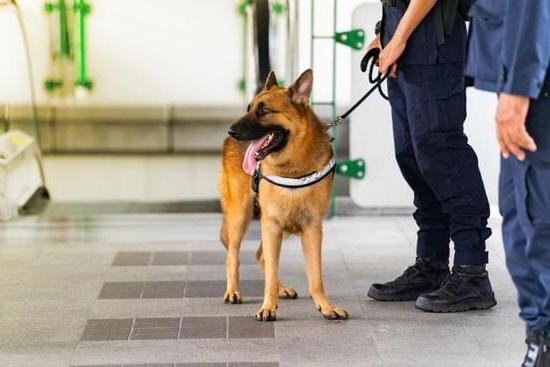Crate training can be a beneficial tool for both you and your dog. It provides a safe and comfortable space for your furry friend while also aiding in their behavior and potty training.
In this article, we will provide you with a comprehensive guide on how to train a dog to be in a crate. From understanding the purpose of crate training to troubleshooting common issues, we will cover everything you need to know to make the process smooth and successful.
When it comes to crate training, many pet owners may feel hesitant or unsure about how to proceed. However, with the right approach and techniques, crate training can be a positive experience for both you and your dog. In the following sections, we will delve into the steps involved in crate training, including choosing the right crate for your dog, introducing them to the crate, making it a positive space, and gradually increasing their time in the crate.
By following our guide and incorporating consistent positive reinforcement methods, you can set your dog up for success when it comes to being in a crate. Additionally, we will address common issues that may arise during the training process and provide tips for handling separation anxiety. With dedication and patience, you can enjoy the benefits of successful crate training with your beloved canine companion.
Choosing the Right Crate for Your Dog
When it comes to crate training your dog, choosing the right crate is essential for their comfort and safety. There are different types of crates available, including wire crates, plastic crates, and soft-sided crates. The size of the crate is also important – it should be spacious enough for your dog to stand up, turn around, and lie down comfortably.
To choose the right crate for your dog, consider their size and weight. Measure your dog from the tip of their nose to the base of their tail to determine the appropriate length for the crate. As for height, measure your dog from the top of their head to the ground while they are sitting and add a few inches to that measurement to ensure there is enough headroom inside the crate.
Once you have chosen a suitable crate for your dog, make sure to place it in a quiet and comfortable location in your home. It’s important to make the crate inviting for your dog by adding a comfortable bed or blanket inside.
Additionally, you can place some of your dog’s favorite toys or treats in the crate to make it more appealing. By creating a positive association with the crate, you can help ease any anxiety or apprehension your dog may feel about being confined in it.
Introducing Your Dog to the Crate
Creating a Positive Association
The key to successfully introducing your dog to a crate is to create a positive association with it. Start by placing the crate in an area where your dog spends a lot of time, such as the living room or bedroom. Leave the door open and put a soft blanket or your dog’s favorite toy inside to encourage them to explore it. Allow them to go in and out of the crate freely without shutting the door.
Feeding Time in the Crate
Another effective way to introduce your dog to the crate is by associating it with something positive, such as mealtime. Place your dog’s food bowl at the back of the crate and leave the door open while they eat. This will help them understand that being inside the crate is a pleasant experience and not something to be feared.
Positive Reinforcement
Using positive reinforcement can also help your dog become more comfortable with the crate. Whenever they voluntarily enter the crate, offer praise and treats to reinforce their good behavior. It’s important not to force them into the crate or use it as a form of punishment, as this can create negative associations with it. With patience and consistent positive reinforcement, your dog will eventually learn that being in the crate is a safe and enjoyable experience.
By gradually introducing your dog to the crate in a positive way, you can help them feel more comfortable and secure when inside it. Using these methods will ensure that your dog sees their crate as a safe haven rather than a place of confinement or punishment.
Making the Crate a Positive Space
Once you have successfully introduced your dog to the crate and they are comfortable spending short periods of time inside, the next step is to make the crate a positive space for them. This will help them associate the crate with positivity and safety, making it easier for them to spend longer periods of time in it.
One way to make the crate a positive space is by placing familiar and comforting items inside, such as their favorite toys, a blanket with your scent, or a piece of clothing that smells like you. This will help your dog feel at ease and relaxed while in the crate.
Another important aspect of making the crate a positive space is to never use it as a form of punishment. The crate should always be associated with positive experiences, such as meal times, treats, or quiet rest periods. Using the crate as a place for time-outs or reprimands can create negative associations and hinder the training process.
It’s also crucial to provide plenty of praise and rewards when your dog willingly enters the crate on their own. This will reinforce their positive behavior and encourage them to see the crate as a safe and enjoyable space. With patience and consistency, you can train your dog to love their crate and see it as their own special den.
| Aspect | Relevance |
|---|---|
| Crate contents | Comforting items inside |
| Punishment | Avoid using crate as punishment |
| Praise | Provide praise when entering willingly |
Gradual Crate Time Increase
So, you’ve successfully introduced your dog to the crate and made it a positive space. Now it’s time to gradually increase the time your dog spends in the crate. This is an important step in crate training, as it helps your dog get accustomed to spending longer periods of time in their crate without feeling anxious or distressed.
Start Slow
When it comes to increasing crate time, it’s essential to start slow. Begin by leaving your dog in the crate for just a few minutes at a time while you’re still at home. You can give them a special treat or toy to keep them occupied during this short period. Gradually increase the duration by a few minutes each time, making sure to praise and reward your dog for remaining calm and relaxed.
Practice Positive Reinforcement
As you extend the amount of time your dog spends in the crate, continue using positive reinforcement techniques. This could involve giving them treats, verbal praises, or a favorite toy whenever they enter their crate willingly and stay calm inside. This will help them associate being in the crate with positive experiences and reduce any anxiety they may have about being confined.
Be Patient
It’s important to be patient during this process and not rush the increase in crate time. Every dog is different, and some may take longer to adjust to spending extended periods in their crate than others. Watch for signs of distress or discomfort, and if necessary, go back to shorter durations before attempting to increase the time again.
Remember that consistency is key when it comes to training your dog to be in a crate for longer periods. With patience, positive reinforcement, and gradual increases in time spent inside the crate, your furry friend will soon see their special space as a safe and comfortable retreat.
Using Treats and Positive Reinforcement
Using Treats for Positive Association
When it comes to crate training, using treats can be a powerful tool for creating a positive association with the crate. Start by placing some of your dog’s favorite treats near the crate and gradually move them closer inside. Encourage your dog to enter the crate by placing treats inside and giving verbal praise when they go in. This will help your dog see the crate as a rewarding and positive space.
Positive Reinforcement Techniques
In addition to using treats, positive reinforcement can play a crucial role in crate training. Whenever your dog willingly enters the crate, offer verbal praise and gentle petting to show approval. It’s important to make sure that your dog feels safe and comfortable inside the crate, so positive reinforcement can help build their confidence and trust in this new space.
Transitioning From Treats to Verbal Cues
As your dog becomes more accustomed to being in the crate, you can gradually reduce their reliance on treats and focus more on verbal cues. Start by using a command such as “crate” or “go to bed” when encouraging your dog to enter the crate. Pairing this command with treats initially and then phasing out the treats as they become more familiar with the cue can help reinforce this behavior without constant treat rewards.
By implementing these techniques, you can effectively use treats and positive reinforcement to train your dog to be in a crate, helping them view it as a comfortable and secure place of their own. Remember that every dog is unique, so it’s essential to be patient and consistent throughout this process.
Handling Separation Anxiety
Separation anxiety is a common issue when crate training a dog. Many dogs may display signs of distress, such as whining, barking, and attempting to escape the crate when left alone. This can be challenging for both the dog and the owner. However, with patience and consistency, it is possible to help your dog overcome separation anxiety and become comfortable in their crate.
Here are some tips for handling separation anxiety when crate training your dog:
- Gradual Alone Time: Start by leaving your dog in the crate for short periods of time and gradually increase the duration as they become more comfortable.
- Desensitization: Practice leaving and returning to the house multiple times throughout the day without making a big fuss. This will help your dog understand that your absence is not a cause for concern.
- Comfort Items: Place comforting items such as a favorite toy or blanket inside the crate to create a positive association with being inside.
It’s important to remember that overcoming separation anxiety takes time and patience. It’s essential to remain calm and avoid punishing your dog for their anxious behavior. With consistent training and positive reinforcement, you can help your dog feel safe and secure in their crate.
By following these tips on how to train a dog to be in a crate, you can help your furry friend become comfortable and happy in their own space. Consistency and patience are key when it comes to successfully crate training any dog.
Tips for Successful Crate Training
Successfully crate training a dog requires patience, consistency, and positive reinforcement. Here are some tips for successful crate training to help make the process smoother for both you and your furry friend.
First, it’s important to start crate training gradually. Introduce the crate to your dog slowly, allowing them to explore it at their own pace. Avoid forcing your dog into the crate as this can create negative associations with the space. Instead, encourage them to enter the crate willingly by using treats and praise.
Another tip for successful crate training is to make the crate a comfortable and inviting space for your dog. Add soft bedding or blankets to make the crate cozy, and consider adding some of your dog’s favorite toys or treats inside. This will help create a positive association with the crate and make it a place they enjoy spending time in.
Consistency is key when it comes to successful crate training. Stick to a regular schedule for feeding, potty breaks, playtime, and crate time. This will help your dog understand what is expected of them and create a sense of routine. Additionally, be consistent with using commands such as “crate” or “kennel up” when guiding your dog into the crate, and always reward them for following these commands.
By following these tips for successful crate training and being patient with your dog, you can help them learn to see the crate as a safe and comfortable space they can retreat to whenever needed. Remember that every dog is different, so it’s important to tailor your approach to suit your individual pet’s personality and needs when learning how to train a dog to be in a crate.
Troubleshooting Common Crate Training Issues
When crate training your dog, it’s important to understand that there may be some common issues that could arise during the process. Some dogs may struggle with being in a crate initially, and as a pet owner, it’s essential to troubleshoot these issues in order to make the training process successful.
One common issue is when the dog whines or barks excessively while in the crate. This behavior can be distressing for both the pet and the owner, but it’s important to address it calmly and patiently.
Another frequent issue is when a dog becomes anxious or destructive while in the crate. This can happen if the dog hasn’t been properly introduced to the crate or if they have negative associations with it. Understanding how to train a dog to be in a crate without experiencing anxiety or becoming destructive is crucial for successful training.
It’s also common for dogs to resist going into their crate altogether. They may show signs of fear or reluctance, making it challenging for owners to acclimate them to this new space. Addressing these issues requires patience and consistency, as well as using positive reinforcement techniques to make the crate a comfortable and enjoyable space for the dog.
| Common Crate Training Issues | Troubleshooting Tips |
|---|---|
| Excessive whining or barking | Provide comfort items such as toys or blankets, and gradually increase crate time |
| Anxiety/destructive behavior | Slowly introduce the dog to the crate with positive associations, use calming aids like pheromone sprays |
| Resistance going into the crate | Use treats and positive reinforcement, create a routine around entering and exiting the crate |
The Importance of Consistency in Crate Training
Consistency is key when it comes to crate training your dog. In order for your dog to truly understand and feel comfortable in their crate, it is important to be consistent in all aspects of the training process. Here are some tips on how to maintain consistency in crate training:
1. Establishing a Routine: Dogs thrive on routine, so it’s important to establish a consistent schedule for crate time. This includes regular feeding times, potty breaks, and designated crate time. By sticking to a routine, your dog will learn to anticipate when it’s time to go in the crate and when they will be let out.
2. Using the Same Verbal Cues: Using consistent verbal cues can help your dog understand what is expected of them. Whether it’s using a specific command like “crate” or “kennel up,” using the same cue every time will help your dog associate that word with going into their crate.
3. Consistent Positive Reinforcement: Positive reinforcement is essential in crate training, and it’s important to be consistent with it. Whenever your dog goes into their crate willingly or exhibits calm behavior inside, make sure to reward them with praise, treats, or toys every time.
In addition to these tips, consistency also means being patient and not giving up on the process. It may take some time for your dog to fully adjust to being in the crate, but by consistently following these guidelines, you can help your furry friend feel safe and comfortable in their own space over time. Remember that every dog is different, so be patient and stay consistent in your approach.
Conclusion
In conclusion, crate training can be a beneficial tool for both you and your dog when done correctly. By understanding the purpose of crate training and choosing the right crate for your dog, you can create a safe and positive space for them. Introducing your dog to the crate with patience and making it a positive environment through treats and positive reinforcement is key in successful crate training.
It’s important to remember that crate training takes time and patience, so gradual crate time increase is essential to avoid causing anxiety or distress to your dog. Handling separation anxiety with care and consistency is also crucial in ensuring that your dog feels comfortable in their crate.
By following these tips for successful crate training and addressing common issues, you will eventually enjoy the benefits of having a well-trained dog that is comfortable being in a crate. Whether it’s for travel, safety, or giving them a quiet place to relax, crate training can provide peace of mind for both you and your furry companion.
Consistency is key in this process, so remain patient and dedicated in helping your dog learn how to be in a crate. With time and effort, you can successfully train your dog to be in a crate.
Frequently Asked Questions
How Long Does It Take for a Dog to Get Used to a Crate?
The time it takes for a dog to get used to a crate varies depending on the individual dog. Some dogs may adjust within a few days, while others may take weeks. It’s important to be patient and consistent during the training process.
At What Age Is It Too Late to Crate Train a Dog?
It is generally not too late to crate train a dog, as they can learn new behaviors at any age. However, it may take longer for older dogs to adapt to being crated, especially if they have never been introduced to one before.
How Do You Start Crate Training a Dog?
When starting crate training, it’s important to make the crate a positive and comfortable space for the dog. This can be done by placing their favorite toys or treats inside and encouraging them to explore it at their own pace.
Additionally, gradually increasing the amount of time they spend in the crate can help them acclimate to being confined in that space.

Welcome to the blog! I am a professional dog trainer and have been working with dogs for many years. In this blog, I will be discussing various topics related to dog training, including tips, tricks, and advice. I hope you find this information helpful and informative. Thanks for reading!





